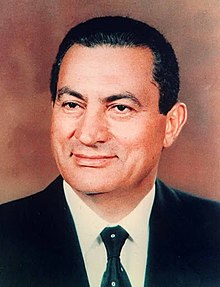
Back Hosni Mubarak Afrikaans ሆስኒ ሙባረክ Amharic Hosni Mubarak AN حسني مبارك Arabic ܚܘܣܢܝ ܡܘܒܐܪܟ ARC حسني مبارك ARY محمد حسنى مبارك ARZ Hosni Mubarak AST Hüsnü Mübarək Azerbaijani Hosni Mubarak BCL
Hosni Mubarak حسني مبارك | |
|---|---|
 Mubarak in 2009 | |
| President of Egypt | |
| In office 14 October 1981 – 11 February 2011 | |
| Prime Minister | Ahmad Fuad Mohieddin Kamal Hassan Ali Aly Lotfy Mahmoud Atef Sedky Kamal Ganzouri Atef Ebeid Ahmed Nazif Ahmed Shafik |
| Vice President | Omar Suleiman[a] |
| Preceded by | Sufi Abu Taleb (Acting) |
| Succeeded by | Mohamed Hussein Tantawi (acting) Mohamed Morsi[1][2][3] |
| Prime Minister of Egypt | |
| In office 7 October 1981 – 2 January 1982 | |
| President | Sufi Abu Taleb (Acting) |
| Preceded by | Anwar El Sadat |
| Succeeded by | Ahmad Fuad Mohieddin |
| Vice President of Egypt | |
| In office 16 April 1975 – 14 October 1981 | |
| President | Anwar El Sadat |
| Preceded by | Hussein el-Shafei |
| Succeeded by | Omar Suleiman[a] |
| Secretary General of the Non-Aligned Movement | |
| In office 16 July 2009 – 11 February 2011 | |
| Preceded by | Raúl Castro |
| Succeeded by | Mohamed Hussein Tantawi (Acting) |
| Commander of the Air Force | |
| In office 23 April 1972 – 16 April 1975 | |
| President | Anwar El Sadat |
| Preceded by | Ali Mustafa Baghdady |
| Succeeded by | Mahmoud Shaker |
| Director of the Egyptian Air Academy | |
| In office 1967–1969 | |
| Preceded by | Yahia Saleh Al-Aidaros |
| Succeeded by | Mahmoud Shaker |
| Personal details | |
| Born | 4 May 1928 Kafr-El Meselha, Kingdom of Egypt |
| Died | 25 February 2020 (aged 91) Cairo, Egypt |
| Political party | National Democratic Party (1978-2011) |
| Spouse(s) | |
| Children | |
| Alma mater | |
| Signature | |
| Military service | |
| Allegiance | |
| Branch/service | |
| Years of service | 1950–1975 |
| Rank | Air Chief Marshal[c] |
| Commands | Cairo West Air Base Beni Suef Air Base Egyptian Air Academy Egyptian Air Force |
| a. ^ Office vacant from 14 October 1981 to 29 January 2011 b. ^ as Chairman of the Supreme Council of the Armed Forces c. ^ c. military rank withdrawn after trial | |

Muhammad Hosni Said Mubarak (Arabic: محمد حسنى سيد مبارك; 4 May 1928 – 25 February 2020), commonly known as Hosni Mubarak (حسنى مبارك), was an Egyptian politician. He served as President of Egypt from 14 October 1981 to 11 February 2011.
Mubarak became the vice-president of the Republic of Egypt after moving up the ranks of the Egyptian Air Force. Then he became the President after President Anwar Sadat was assassinated on 6 October 1981. His almost thirty-year presidency made him Egypt's longest-serving ruler since Muhammad Ali Pasha.[4]
As President of Egypt, Mubarak is thought to have been one of the most powerful leaders in the region. Under the 1971 Constitution of Egypt, Mubarak exercised strong control over the country and was generally considered a dictator. In 2005, he called an election and easily won it. Many opponents believed Mubarak changed the election results so he could win.
In early 2011, during the Arab Spring, there were huge protests against his government. In the end, Mubarak resigned and handed over power to the armed forces. It is hoped that elections later that year for a new government. On 2 June 2012, Mubarak was sentenced to life imprisonment for ordering the shooting of protesters in the revolution that ousted him.
On 13 January 2013, Egypt's Court of Cassation overturned Mubarak's sentence and ordered a retrial.[5] On retrial, Mubarak and his sons were convicted on 9 May 2015 of corruption and given prison sentences.[6] Mubarak was detained in a military hospital and his sons were freed 12 October 2015 by a Cairo court.[7]
He was acquitted on 2 March 2017 by the Court of Cassation and released on 24 March 2017.[8][9]
He died on 25 February 2020 at a Cairo hospital after having surgery, aged 91.[10][11]
- ↑ Conal Urquhart and agencies (30 June 2012). "Mohamed Morsi sworn in as Egyptian president". The Guardian. Retrieved 1 July 2012.
- ↑ Samer al-Atrush (1 July 2012). "Morsi sworn in as Egypt president". Herald Sun. Retrieved 1 July 2012.
- ↑ Yasmine Saleh and Shaimaa Fayed (24 June 2012). "Islamist Morsy wins Egyptian presidency with 52 pct". Reuters Africa. Archived from the original on 27 June 2012. Retrieved 1 July 2012.
- ↑ Slackman, Michael (8 March 2010). "Hosni Mubarak". The New York Times. Retrieved 25 January 2011.
- ↑ Egypt's Mubarak to get retrial Archived 20 January 2013 at the Wayback Machine. 3 News. Retrieved on 2014-01-16.
- ↑ "Egypt's Hosni Mubarak jailed in corruption retrial". BBC News. 9 May 2015. Retrieved 9 May 2015.
- ↑ "Jailed sons of Egypt's deposed leader Hosni Mubarak freed". Associated Press. 13 October 2015.
- ↑ "Egypt's Hosni Mubarak acquitted over 2011 protester deaths". 3 March 2017.
- ↑ "Egypt's Hosni Mubarak freed after six years in detention". BBC News. 24 March 2017. Retrieved 24 March 2017.
- ↑ "Egypt's former president Hosni Mubarak dies at 91". www.aljazeera.com. Retrieved 2020-02-25.
- ↑ "Former Egyptian president Hosni Mubarak dies". BBC News. 2020-02-25. Retrieved 2020-02-25.